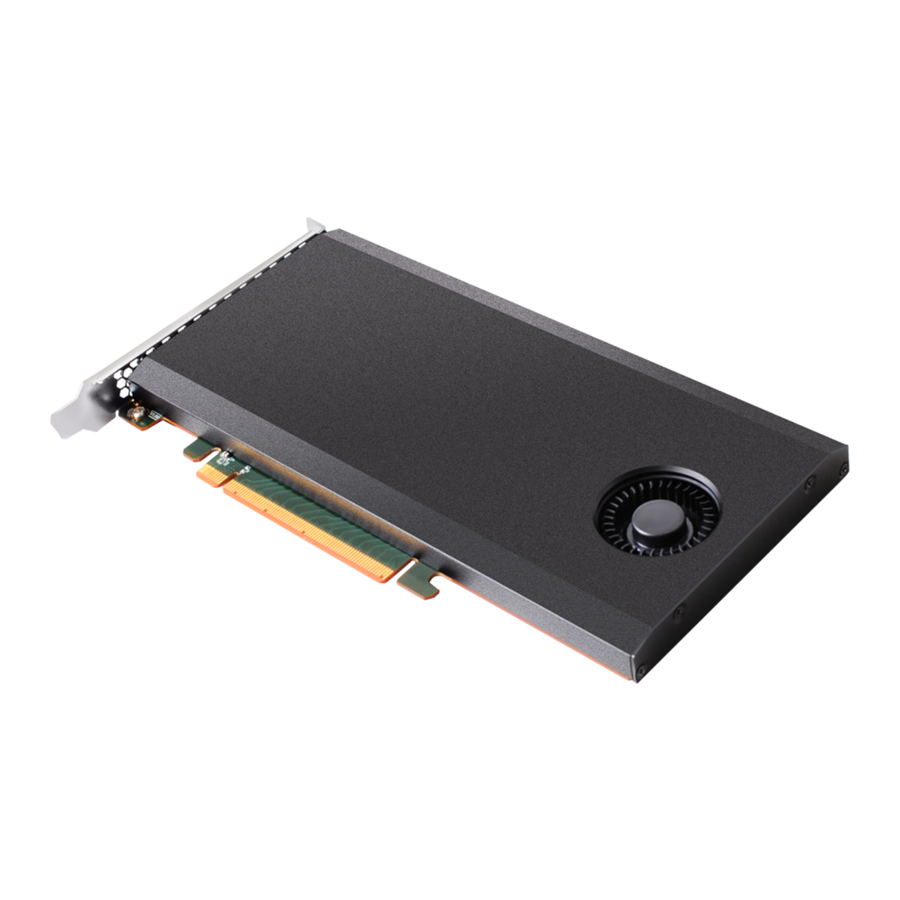
HighPoint SSD7103 Installation Manual
Nvme raid controller linux centos7.8 installation guide
Hide thumbs
Also See for SSD7103:
- Installation manual (15 pages) ,
- Quick installation manual (9 pages) ,
- Installation manual (12 pages)
Table of Contents

Summary of Contents for HighPoint SSD7103
- Page 1 SSD7103 Linux CentOS7.8 Installation Guide HighPoint NVMe RAID Controller SSD7103 Linux CentOS7.8 Installation Guide Version 1.00 Copyright © 2020 HighPoint Technologies, Inc. All rights reserved. Last updated on July 28, 2020...
-
Page 2: Table Of Contents
Step 1 Prepare Your Hardware for Installation ................. 1 Step 2 Check System EFI Settings .................... 1 Step 3 Flash UEFI Rom to SSD7103 ..................3 Step 4 Create Array ........................4 Step 5 Prepare the Driver Diskette .................... 5 Step 6 Install Linux CentOS7.8 .................... -
Page 3: Overview
SSD7103 only support EFI boot. If you have other SCSI adapters installed, you must make sure the SSD7103 controller EFI will be loaded firstly. If not, try to move it to another PCI slot. Otherwise you may be unable to boot up your system. - Page 4 SSD7103 Linux CentOS7.8 Installation Guide And ‘Advanced->PCIe/PCI/PnP Configuration CPU Slot PCI-E OPROM’ to ‘EFI’. If the SSD7103 has been connected to the motherboard CPU1Slot2 PCI-E X16, you should set "CPU1Slot2 PCI-E X16 OPROM" to "EFI"; Disable ‘Secure Boot’, set ‘Secure Boot’ to ‘Disabled’;...
-
Page 5: Step 3 Flash Uefi Rom To Ssd7103
Set " Boot->Secure Boot->OS Type" to "Other OS". Step 3 Flash UEFI Rom to SSD7103 Unzip SSD7103 UEFI package to root dir (/) of a USB flash driver, and insert the USB flash drive to the motherboard; Booting from the UEFI USB flash and enter the UEFI environment;... -
Page 6: Step 4 Create Array
SSD7103 Linux CentOS7.8 Installation Guide Step 4 Create Array Attach four NVMe SSD to SSD7103 Controller; Note Make sure your USB flash partition format is FAT32. Boot, in the presence of the motherboard Log screen, there will be NVMe SSD information:... -
Page 7: Step 5 Prepare The Driver Diskette
SSD7103 Linux CentOS7.8 Installation Guide Command “exit”; For more command usages, refer to Appendix A. Step 5 Prepare the Driver Diskette Extract HighPoint_NVMe_CentOS_7u8_x86_64_ vx.x.x_xx_xx_xx.tar.gz to top(/) directory of an USB flash drive. It will look like: Step 6 Install Linux CentOS7.8 sert the USB flash drive to the target system. - Page 8 SSD7103 Linux CentOS7.8 Installation Guide d. When following messages show up, type the line number that line with the LABEL of USB flash drive. In this example, type 1 and press Enter e. Choose driver disk ISO file, In this example, type 1 and press Enter Select drivers to install [ ]/media/DD-2/rpms/x86_64/kmod-redhat-hptnvme-v1.2.13-20_03_25_el7.8.x86_6...
- Page 9 SSD7103 Linux CentOS7.8 Installation Guide Refer to RHEL/CentOS Linux installation guide to continue the installation and when installation finishes and prompts you to reboot the system: Open source driver needs to be installed after system installation. Run the .bin file to install the driver package.
-
Page 10: Monitoring The Driver
This command will show the driver version number, physical device list and logical device list. 4 Installing RAID Management Software HighPoint RAID Management Software is used to configure and keep track of your hard disks and RAID arrays attached to controller. - Page 11 SSD7103 Linux CentOS7.8 Installation Guide Install Linux open source driver. Run the .bin file to install the driver package. Linux open source driver link: https://highpoint-tech.com/BIOS_Driver/SSD7103/HighPoint_NVMe_G5_Linux_Src_v1.2. 14_2020_04_22.tar.gz # sh hptnvme_g5_linux_src_vxx.x.x_xx_xx_xx.bin The driver installation is complete, and the reboot can enter the system where the new kernel is located.
- Page 12 SSD7103 Linux CentOS7.8 Installation Guide Appendix A Support command: help/info/quit/exit/create/delete. Create Command Syntax Create Array Type (RAID0/RAID1/RAID10) Member Disk list (1/1,1/2|*)Capacity(100|*) Examples <<< create RAID0 <<< create RAID0 * <<< create RAID0 * * Create RAID0 array with all disks and with maximum capacity.













